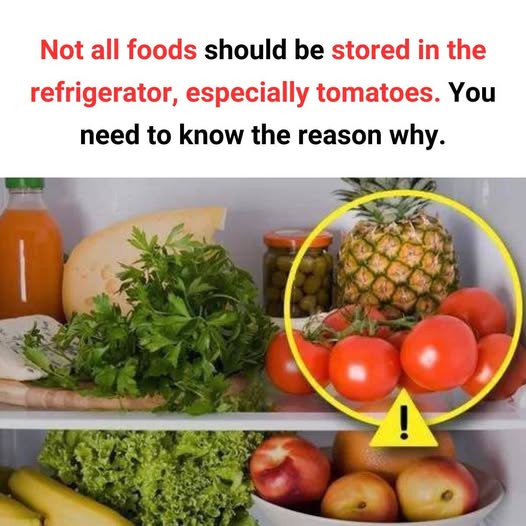ADVERTISEMENT
Why You Should Avoid Storing Tomatoes in the Refrigerator
- Loss of Flavor: Tomatoes are packed with natural sugars and acids that give them their signature rich, juicy flavor. When tomatoes are refrigerated, the cold temperatures slow down the process of sugar and acid development, which leads to a decrease in taste. The result is a bland, less flavorful tomato that doesn’t have that fresh, vibrant taste you crave.
- Textural Changes: Cold temperatures can also impact the texture of tomatoes. Refrigeration causes the fruit’s cell walls to break down, which leads to mushiness when you remove them from the fridge. The firm, satisfying bite of a room-temperature tomato is lost in favor of a squishy, undesirable texture.
- Reduced Ripening: If you store tomatoes in the refrigerator too early—before they’ve fully ripened—they won’t be able to continue their natural ripening process. This means you may end up with tomatoes that never reach their full flavor potential. Ideally, tomatoes should ripen at room temperature, which allows them to reach their peak sweetness and juiciness.
- Increased Ethylene Gas: Tomatoes, like many fruits, produce ethylene gas as they ripen. This gas accelerates the ripening process, but if tomatoes are placed in the fridge too soon, the cold environment can interfere with how the gas behaves. This can cause premature ripening and a shorter shelf life for other nearby fruits, resulting in wasted produce.
How to Properly Store Tomatoes
Now that you know why you shouldn’t refrigerate tomatoes, it’s time to learn the best way to store them to keep them fresh, flavorful, and juicy.
- Store Tomatoes at Room Temperature: The best way to store tomatoes is at room temperature, away from direct sunlight. Find a cool, dry spot in your kitchen, such as a countertop or a fruit bowl, where the air circulation is good. This allows the tomatoes to ripen naturally and maintain their full flavor.
- Keep the Stem Side Down: When storing tomatoes, place them with the stem side down. This prevents air from entering the core, which can help slow down the deterioration process and keep them fresher for longer.
- Avoid Stacking Tomatoes: To prevent bruising or squishing, avoid stacking tomatoes on top of each other. Instead, place them in a single layer on a flat surface, allowing each tomato to breathe. If you have a large batch, consider using a shallow container or a flat basket to spread them out evenly.
- Refrigerate Only When Necessary: If your tomatoes are already fully ripe and you won’t be able to eat them in time, you can refrigerate them to extend their shelf life by a few days. However, it’s important to allow them to come to room temperature before eating so you can regain some of their lost flavor. Keep in mind, though, that their texture might still be a bit affected.
- Use a Paper Bag for Overripe Tomatoes: If you have tomatoes that are beginning to soften or ripen too quickly, you can place them in a paper bag. The bag will help concentrate the ethylene gas around the tomatoes, accelerating the ripening process in a controlled way. This is particularly useful if you have a surplus of tomatoes and want to ensure they ripen evenly.
When to Refrigerate Tomatoes
While tomatoes generally should not be stored in the fridge, there are certain situations where refrigeration can be beneficial:
- Overripe Tomatoes: If you’ve bought tomatoes that are already very ripe or have been cut open, placing them in the refrigerator can help preserve them for a little while longer. But make sure to let them return to room temperature before eating to bring back some of the flavor.
- Prepared Dishes: If you’ve made a salad, sauce, or dish that contains fresh tomatoes, it’s best to refrigerate the leftovers to keep them safe for later. Just be aware that the tomatoes will likely lose some of their texture and flavor as they cool.
Conclusion: Enjoy Tomatoes at Their Best by Storing Them Right
While the refrigerator is the go-to storage spot for many types of food, tomatoes are an exception to the rule. Storing them at room temperature allows them to ripen naturally, retaining their rich flavor and satisfying texture. So, the next time you buy tomatoes, resist the urge to put them in the fridge—your taste buds will thank you!
By following these simple storage tips, you’ll be able to enjoy tomatoes at their peak freshness, whether you’re slicing them onto a salad, making a homemade sauce, or just enjoying a delicious tomato sandwich. After all, the full flavor of a tomato is one of the joys of cooking and eating fresh produce, and proper storage is key to bringing out that bright, juicy taste.
